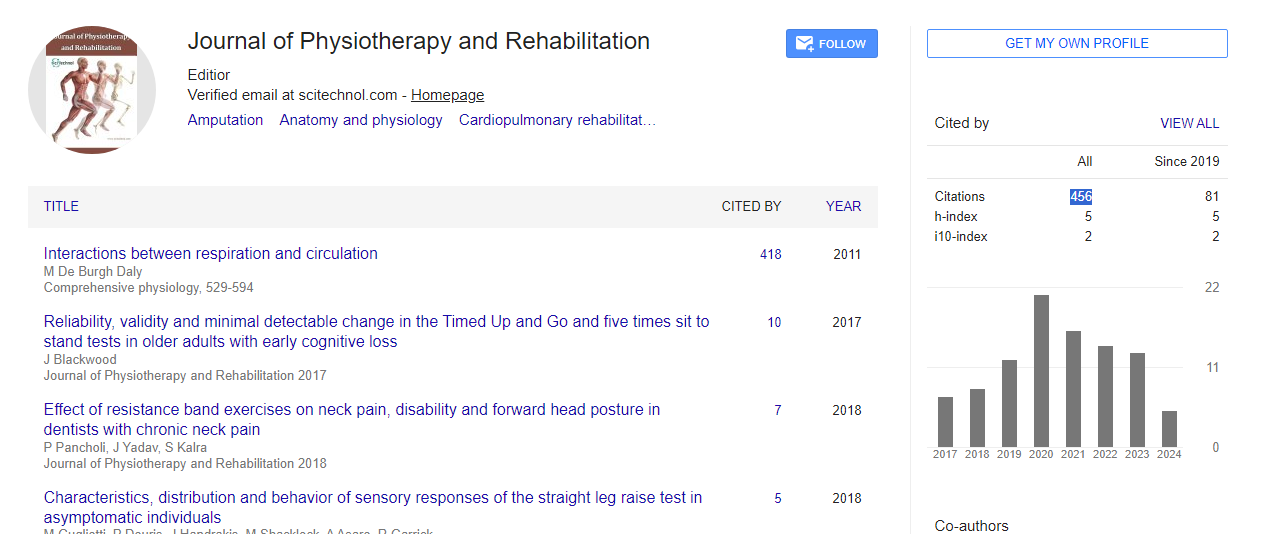Perspective, J Physiother Rehabi Vol: 8 Issue: 3
Impact of Kinesio Taping in Sports Physical Therapy: Applications and Benefits
Alejardo Bart*
1Department of Sport Physiotherapy, Pontifical Catholic University of Argentina, Buenos Aires, Argentina
*Corresponding Author: Alejardo Bart,
Department of Sport Physiotherapy,
Pontifical Catholic University of Argentina, Buenos Aires, Argentina
E-mail: bartale@jardo.ag
Received date: 28 May, 2024, Manuscript No. JPTR-24-140178;
Editor assigned date: 30 May, 2024, PreQC No. JPTR-24-140178 (PQ);
Reviewed date: 13 June, 2024, QC No. JPTR-24-140178;
Revised date: 21 June, 2024, Manuscript No. JPTR-24-140178 (R);
Published date: 28 June, 2024, DOI: 10.4172/JPTR.1000167.
Citation: Bart A (2024) Impact of Kinesio Taping in Sports Physical Therapy: Applications and Benefits. J Physiother Rehabi 8:3.
Description
Kinesio Taping involves the application of thin, elastic adhesive tapes on the skin to provide support and stability to muscles and joints without restricting movement. Unlike traditional athletic tapes, Kinesio Tape is designed to mimic the elasticity of human skin, allowing for a wide range of motion. Its distinctive wave-like pattern and stretch properties aim to facilitate natural body mechanics and promote healing. Kinesio Taping has emerged as a popular adjunctive therapy in sports physical therapy, revolutionizing the approach to managing injuries and enhancing athletic performance.
Mechanisms of kinesio taping
One of the key mechanisms behind Kinesio Taping is its interaction with the neurosensory system. The tape's application creates a lifting effect on the skin, which is believed to enhance sensory feedback and proprioception-the body's ability to sense its position and movement in space. This sensory stimulation is thought to influence motor control and muscle activation patterns, aiding in neuromuscular reeducation and improving functional movement. While providing neurosensory feedback, Kinesio Tape also offers mechanical support to muscles and joints. The tape's elastic properties allow it to provide dynamic support without restricting movement, making it suitable for both injury prevention and rehabilitation. By maintaining proper alignment and reducing excessive strain on injured tissues, Kinesio Taping promotes optimal biomechanics during athletic activities.
Kinesio Taping is widely used in sports physical therapy for managing a variety of musculoskeletal injuries. It can be applied to support joints affected by conditions such as sprains, strains, and tendonitis. The tape's ability to relieve pain, reduce swelling, and improve circulation facilitates the healing process and allows athletes to resume training and competition sooner. For instance, in ankle sprains, Kinesio Tape may be applied to provide external support while promoting ankle stability and proprioceptive feedback. Similarly, in shoulder injuries like rotator cuff strains, the tape can assist in maintaining proper shoulder mechanics during rehabilitation exercises, preventing further injury. One of the primary advantages of Kinesio Taping is its non-invasive nature. Unlike surgical interventions or pharmaceutical treatments, the application of Kinesio Tape involves no drugs or invasive procedures, making it a safe and accessible option for athletes of all ages and skill levels. Its gentle adhesive and breathable material reduce the risk of skin irritation, allowing for prolonged use during training and competition.
Kinesio Tape can be applied in various configurations to target specific muscles, joints, or movement patterns based on individual needs. Its flexibility and ease of application make it a versatile tool in sports physical therapy clinics, athletic training rooms, and even during field events. Athletes and coaches can learn basic taping techniques, enabling them to incorporate Kinesio Taping into daily training routines and recovery protocols. Beyond its physical benefits, Kinesio Taping can have psychological effects on athletes. The visible application of the tape provides a tangible reminder of support and injury management, boosting athlete confidence and adherence to rehabilitation programs. This psychological reinforcement can be particularly valuable during the recovery phase, helping athletes maintain motivation and focus on their rehabilitation goals.
Conclusion
Kinesio Taping has revolutionized sports physical therapy by offering a non-invasive, versatile, and effective adjunctive treatment for managing injuries and enhancing athletic performance. Through its mechanisms of neurosensory feedback and mechanical support, the tape facilitates healing, improves movement mechanics, and supports injury prevention strategies. As research continues to explore its applications and refine techniques, Kinesio Taping remains a valuable tool in optimizing the health and performance of athletes worldwide. Its integration into sports rehabilitation protocols underscores its role in promoting recovery, resilience, and athletic success.
 Spanish
Spanish  Chinese
Chinese  Russian
Russian  German
German  French
French  Japanese
Japanese  Portuguese
Portuguese  Hindi
Hindi 